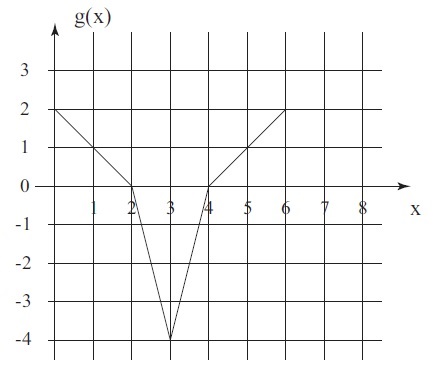Science:Math Exam Resources/Courses/MATH103/April 2006/Question 01 (a)
{{#incat:MER QGQ flag|{{#incat:MER QGH flag|{{#incat:MER QGS flag|}}}}}}
• Q1 (a) • Q1 (b) • Q1 (c) • Q1 (d) • Q1 (e) • Q1 (f) • Q2 (a) • Q2 (b) • Q2 (c) • Q2 (d) • Q2 (e) • Q3 (a) • Q3 (b) • Q3 (c) • Q3 (d) • Q4 • Q5 (a) • Q5 (b) • Q5 (c) • Q6 (a) • Q6 (b) • Q6 (c) • Q7 (a) • Q7 (b) • Q7 (c) •
Question 01 (a) | ||||||||||||||||||||||||||||||||||||||||||||||||
|---|---|---|---|---|---|---|---|---|---|---|---|---|---|---|---|---|---|---|---|---|---|---|---|---|---|---|---|---|---|---|---|---|---|---|---|---|---|---|---|---|---|---|---|---|---|---|---|---|
|
For each of the following multiple-choice questions, there is one correct answer. Circle the corresponding (roman) numeral. a) Use the graph of g(x) below to determine the correct set of values of i.
ii.
iii.
iv.
|
|
Make sure you understand the problem fully: What is the question asking you to do? Are there specific conditions or constraints that you should take note of? How will you know if your answer is correct from your work only? Can you rephrase the question in your own words in a way that makes sense to you? |
|
If you are stuck, check the hints below. Read the first one and consider it for a while. Does it give you a new idea on how to approach the problem? If so, try it! If after a while you are still stuck, go for the next hint. |
Hint 1 |
|---|
|
Substitute x with the values given in the table. Calculate the area of g(x) with basic geometry formula, i.e. area of triangle and area of a square. |
Hint 2 |
|---|
|
The substituted values of x should be 2, 4, 6, 8, as at these points the area under the graph of g(x) can be calculated with the area of triangle formula: base*height/2 |
Hint 3 |
|---|
|
Area below the x-axis has to be subtracted from the net area. |
|
Checking a solution serves two purposes: helping you if, after having used all the hints, you still are stuck on the problem; or if you have solved the problem and would like to check your work.
|
Solution |
|---|
|
The answer is iv. At the point of x=0, G(0)=0 because the top and bottom limits of the integral that defines G(x) are identical. The area that is integrated over has zero width. At the point of x=2, G(2)=2 because the area of the graph can be calculated using the area of triangle formula height*base/2 = 2*2/2 =2 At the point of x=4, G(4)=-2 because the area between the x-axis and the graph g(x) is composed of two triangles with height 4 and width 1. Hence the area is given by 4*1/2 + 4*1/2 = 4. It is below the x-axis, hence we subtract it from the previous value and get G(4) = 2 - 4 = -2. At the point x=6, G(6)=0 because we add the area of the triangle with height 2 and width 2 to the previous value: G(6) = -2 + 2*2/2 = 0 At the point x=8, G(8)=4 because we add the area of the square with height 2 and width 2 to the previous value: G(8) = 0 + 2*2 = 4 |
{{#incat:MER CT flag||
}}


